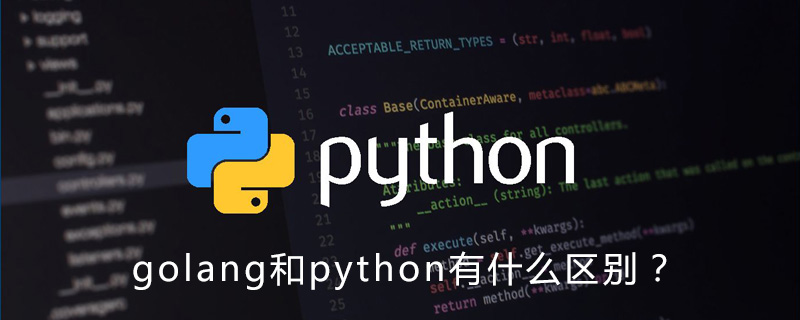
What is the difference between golang and python? The following article will compare Python and Golang and introduce the differences between golang and python. It has certain reference value. Friends in need can refer to it. I hope it will be helpful to everyone.

The difference between golang and python
1. Example
Python is a multi-paradigm, imperative and functional programming language based on object-oriented programming. It adheres to the idea that if a language behaves a certain way in certain contexts, it should ideally work similarly in all contexts. However, it is not a pure OOP language, and it does not support strong encapsulation, which is one of the main principles of OOP.
Go is a procedural programming language based on the concurrent programming paradigm, which has superficial similarities to C. In fact, Go is more like an updated version of C.
2. Typing
Python is a dynamically typed language, while Go is a statically typed language, which actually helps to catch errors at compile time, which Serious errors later in production can be further reduced.
3. Concurrency
Python does not provide a built-in concurrency mechanism, while Go has a built-in concurrency mechanism.
4. Security
Python is a strongly typed language that is compiled, thus adding a layer of security. Go has a type assigned to every variable, therefore, it provides safety. However, if any errors occur, users need to run the entire code themselves.
5. Speed
Go is much faster than Python.
6. Usage
Python is more used in web applications, and it is very suitable for solving data science problems. Go is more around systems programming, i.e. Go is more of a systems language.
7. Managing memory
Go allows programmers to manage memory to a large extent. However, memory management in Python is fully automated and managed by the Python VM; it does not allow the programmer to be responsible for memory management.
8. Libraries
Compared with Go, Python provides a much larger number of libraries. However, Go is still new and hasn't made much progress yet.
9. Grammar
Python’s syntax uses indentation to indicate code blocks. Go's syntax is based on opening and closing parentheses.
10. Level of detail
To obtain the same functionality, Golang code usually requires writing more characters than Python code.
Features
1. Python
①Interpreted language
The program does not need to be compiled before running. It is translated when the program is run. A specialized interpreter is responsible for interpreting the program code when each statement is executed. In this way, the interpreted language needs to be translated every time it is executed, which is relatively inefficient.
②Dynamic data type
supports overloaded operators and generic design. (Operator overloading is to redefine the existing operator and give it another function to adapt to different data types. Generic design means that there is no need to specify the type when defining it, and then specify it when the client uses it. Type)
③Completely object-oriented language
Functions, modules, numbers, and strings are all objects. In Python, everything connected to objects
fully supports inheritance and reuse Contains, multiple inheritance
④Has a powerful standard library
The core of the Python language only contains common types and functions such as numbers, strings, lists, ancestors, dictionaries, sets, files, etc., and is composed of The Python standard library provides additional functions such as system management, network communication, text processing, database interface, graphics system, XML processing, etc.
⑤The community provides a large number of third-party libraries
The Python community provides a large number of third-party modules, which are used in a similar way to the standard library. Their functions cover scientific computing, artificial intelligence, machine learning, web development, database interfaces, and graphics systems.
2. Golang
①Static strongly typed, compiled, concurrent
statically typed language, but has the feeling of a dynamic language. (A statically typed language means that most hidden problems can be checked out during compilation. The feeling of a dynamic language is that there are many packages that can be used, and it is very efficient to write)
can be directly compiled into machine code , does not rely on other libraries, the version of glibc has certain requirements, and deployment is completed by throwing a file up.
The language level supports concurrency. This is the biggest feature of Go. It inherently supports concurrency. Go supports concurrency in its genes. It can make full use of multiple cores and make it easy to use concurrency.
②Garbage collection mechanism
Built-in runtime supports garbage collection. This is one of the characteristics of dynamic languages. Although GC (memory garbage collection mechanism) is not perfect at present, it is enough. Cope with most situations we can encounter, especially GC after Go1.1.
③Support object-oriented programming
There are concepts of interface types and implementation types, but embedding replaces inheritance.
④ Rich standard library
Go currently has a large number of built-in libraries, especially the network library is very powerful.
⑤Embedded C support
Go can also directly contain C code, making use of the existing rich C library
Application
1, Python
①Network programming
Web application, web crawler
②Data analysis and machine learning
③Automated testing
④Automated operation and maintenance
2. Golang
①Server programming
Processing logs and data Packaging, virtual machine processing, file systems, etc.
②Distributed systems, database agents, etc.
③Network programming
This area is currently the most widely used, including Web applications, API applications, and download applications.
④In-memory database
For example, groupcache developed by Google is part of couchbase.
⑥Cloud Platform
Recommended learning: Golang tutorial
The above is the detailed content of What is the difference between golang and python?. For more information, please follow other related articles on the PHP Chinese website!